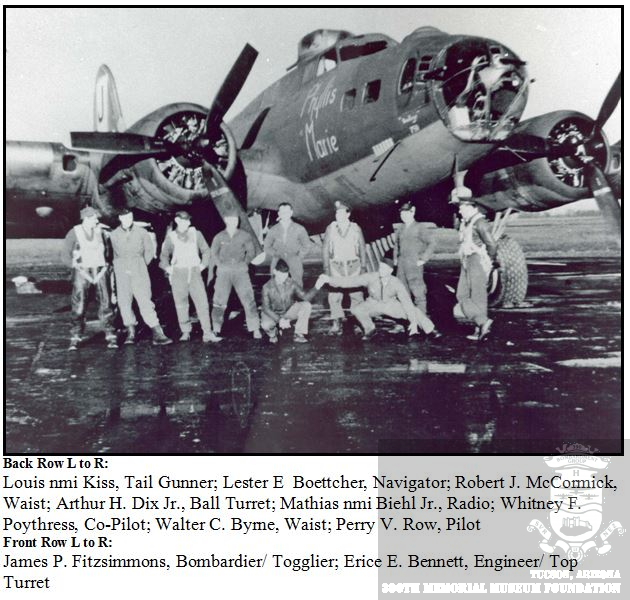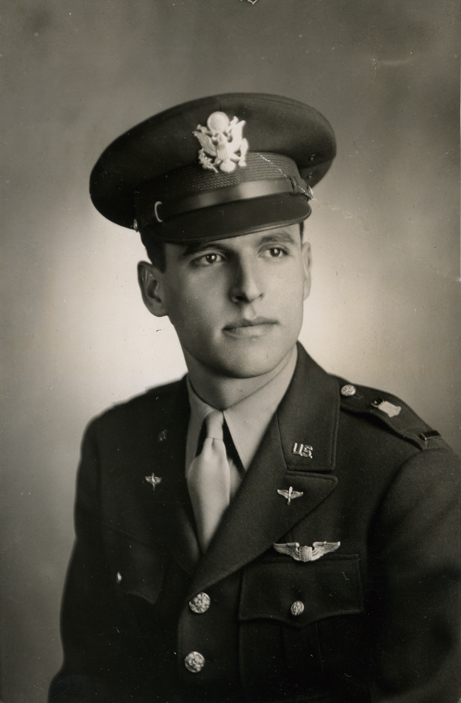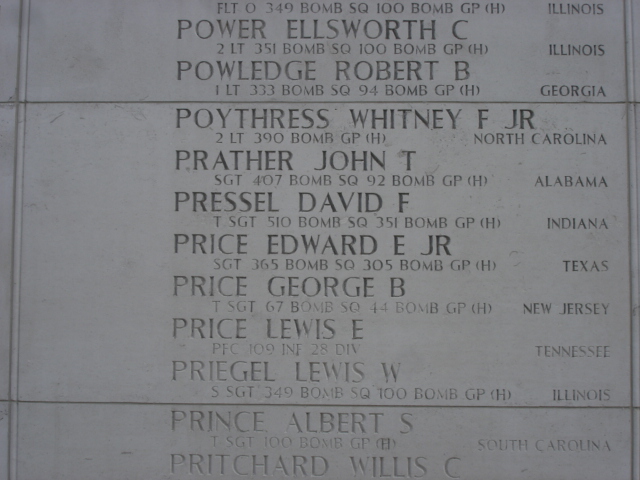On Dec. 11, 1943, for a mission to the port area of Emden, Germany, Lt. (later Captain) Perry V Row, pilot of the B-17 Phyllis Marie was chosen as the Deputy Squadron Leader, and as a result, his best friend and Co-Pilot, Whitney Fulton “Billy” Poythress, was bumped from the flight, his seat being assigned to the Deputy Command Pilot, one of the 390th Bombardment Group's senior officers.
Not wanting to be left back from the mission, Billy wrangled his way on board the Squadron Lead, “Six Nights in Telergma,” piloted by veteran Pilot Hiram Skogmo. Billy was assigned as the Tail Gunner and Observer. It was his duty as Observer to watch the formation of the squadron (18 planes) and direct traffic,
instructing pilots to move their airplanes in closer or out further, as necessary. When Billy, facing backwards, looked to his immediate left, he could see his regular plane, the Phyllis Marie. When Perry looked to his immediate left, he could see the Squadron Lead with Billy in the tail gunner position.
After the squadron crossed the English Channel, at landfall over the Netherlands, six German fighter planes appeared directly in front of the squadron, coming in fast, firing rockets. They concentrated their fire on the Squadron Lead ship, knocking it out of the air. Perry and the crew of the Phyllis Marie watched helplessly, as the plane went down in flames. They counted three parachutes leave the airplane, but not from Billy’s Tail Gunner position. Another 30 enemy aircraft joined the battle, and an additional 4 B-17s were knocked down in the battle.
Lt. Row, as Deputy Squadron Leader, moved into the Lead position, and led the squadron on the bombing raid. When his bombardier called Bombs Away, all the bombardiers in the squadron let loose their bombs. The 390th were later credited with destroying 11 fighters, probably destroying 3 others, and damaging 8. Because of poor weather, the bombing could not be assessed that day. The Phyllis Marie returned to base with no injury and no damage.
Billy, then age 21, was listed as Missing In Action (MIA). One of the three parachutes that fell on Dec 11, 1943 from Six Nights in Telergma, carried a man who became a Prisoner Of War (POW), and after the war, he confirmed that the other 7 crew members that day went down with the ship. Thus sometime after 1947, Billy’s listing was officially changed to Killed In Action (KIA). His name is inscribed on a tablet in one of the American Cemeteries in the Netherlands.
As told by Terry Row, Author of the book, Phyllis Marie, son of Captain Perry Row
Poythress received an Air Medal for his "courage, coolness and skill" during his first 15 missions over occupied Europe. He was on his 18th mission, as Tail Gunner/Observer of a B-17 heavy bomber, when the plane failed to return from a mission over the port of Emden. Poythress was listed as missing in action on Dec. 11, 1942, and was presumed to have died in a notification sent on Dec. 12, 1944.
Poythress' widow, the former Mary Frances Montjoy '44, received his Air Medal with two Oak Leaf Clusters and the Purple Heart.
Source:
GAA Alumni Records;
www.abmc.gov
On Dec. 11, 1943, for a mission to the port area of Emden, Germany, Lt. (later Captain) Perry V Row, pilot of the B-17 Phyllis Marie was chosen as the Deputy Squadron Leader, and as a result, his best friend and Co-Pilot, Whitney Fulton “Billy” Poythress, was bumped from the flight, his seat being assigned to the Deputy Command Pilot, one of the 390th Bombardment Group's senior officers.
Not wanting to be left back from the mission, Billy wrangled his way on board the Squadron Lead, “Six Nights in Telergma,” piloted by veteran Pilot Hiram Skogmo. Billy was assigned as the Tail Gunner and Observer. It was his duty as Observer to watch the formation of the squadron (18 planes) and direct traffic,
instructing pilots to move their airplanes in closer or out further, as necessary. When Billy, facing backwards, looked to his immediate left, he could see his regular plane, the Phyllis Marie. When Perry looked to his immediate left, he could see the Squadron Lead with Billy in the tail gunner position.
After the squadron crossed the English Channel, at landfall over the Netherlands, six German fighter planes appeared directly in front of the squadron, coming in fast, firing rockets. They concentrated their fire on the Squadron Lead ship, knocking it out of the air. Perry and the crew of the Phyllis Marie watched helplessly, as the plane went down in flames. They counted three parachutes leave the airplane, but not from Billy’s Tail Gunner position. Another 30 enemy aircraft joined the battle, and an additional 4 B-17s were knocked down in the battle.
Lt. Row, as Deputy Squadron Leader, moved into the Lead position, and led the squadron on the bombing raid. When his bombardier called Bombs Away, all the bombardiers in the squadron let loose their bombs. The 390th were later credited with destroying 11 fighters, probably destroying 3 others, and damaging 8. Because of poor weather, the bombing could not be assessed that day. The Phyllis Marie returned to base with no injury and no damage.
Billy, then age 21, was listed as Missing In Action (MIA). One of the three parachutes that fell on Dec 11, 1943 from Six Nights in Telergma, carried a man who became a Prisoner Of War (POW), and after the war, he confirmed that the other 7 crew members that day went down with the ship. Thus sometime after 1947, Billy’s listing was officially changed to Killed In Action (KIA). His name is inscribed on a tablet in one of the American Cemeteries in the Netherlands.
As told by Terry Row, Author of the book, Phyllis Marie, son of Captain Perry Row
Poythress received an Air Medal for his "courage, coolness and skill" during his first 15 missions over occupied Europe. He was on his 18th mission, as Tail Gunner/Observer of a B-17 heavy bomber, when the plane failed to return from a mission over the port of Emden. Poythress was listed as missing in action on Dec. 11, 1942, and was presumed to have died in a notification sent on Dec. 12, 1944.
Poythress' widow, the former Mary Frances Montjoy '44, received his Air Medal with two Oak Leaf Clusters and the Purple Heart.
Source:
GAA Alumni Records;
www.abmc.gov
Gravesite Details
Entered the service from North Carolina
Family Members
Sponsored by Ancestry
Advertisement
Advertisement












